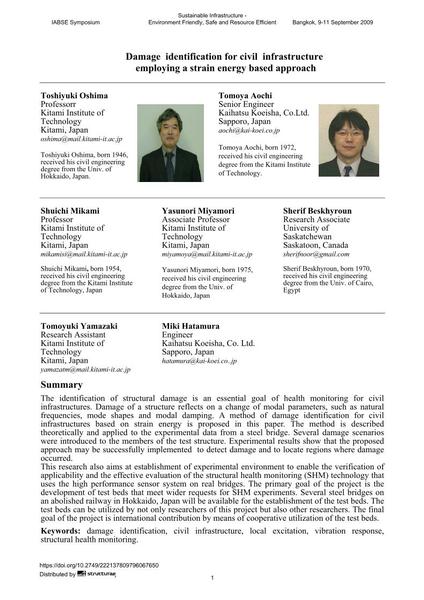Damage identification for civil infrastructure employing a strain energy based approach

|
|
|||||||||||
Bibliografische Angaben
| Autor(en): |
Toshiyuki Oshima
Tomoya Aochi Shuichi Mikami Yasunori Miyamori Sherif Beskhyroun Tomoyuki Yamazaki Miki Hatamura |
||||
|---|---|---|---|---|---|
| Medium: | Tagungsbeitrag | ||||
| Sprache(n): | Englisch | ||||
| Tagung: | IABSE Symposium: Sustainable Infrastructure - Environment Friendly, Safe and Resource Efficient, Bangkok, Thailand, 9-11 September 2009 | ||||
| Veröffentlicht in: | IABSE Symposium Bangkok 2009 | ||||
|
|||||
| Seite(n): | 8-15 | ||||
| Anzahl der Seiten (im PDF): | 8 | ||||
| Jahr: | 2009 | ||||
| DOI: | 10.2749/222137809796067650 | ||||
| Abstrakt: |
The identification of structural damage is an essential goal of health monitoring for civil infrastructures. Damage of a structure reflects on a change of modal parameters, such as natural frequencies, mode shapes and modal damping. A method of damage identification for civil infrastructures based on strain energy is proposed in this paper. The method is described theoretically and applied to the experimental data from a steel bridge. Several damage scenarios were introduced to the members of the test structure. Experimental results show that the proposed approach may be successfully implemented to detect damage and to locate regions where damage occurred. This research also aims at establishment of experimental environment to enable the verification of applicability and the effective evaluation of the structural health monitoring (SHM) technology that uses the high performance sensor system on real bridges. The primary goal of the project is the development of test beds that meet wider requests for SHM experiments. Several steel bridges on an abolished railway in Hokkaido, Japan will be available for the establishment of the test beds. The test beds can be utilized by not only researchers of this project but also other researchers. The final goal of the project is international contribution by means of cooperative utilization of the test beds. |
||||
